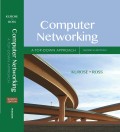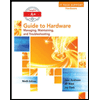
EBK COMPUTER NETWORKING
7th Edition
ISBN: 8220102955479
Author: Ross
Publisher: PEARSON
expand_more
expand_more
format_list_bulleted
Question
Chapter 7, Problem R3RQ
Program Plan Intro
Wireless channel impairment:
Wireless channels is a basis of many types of wireless channel impairments like path loss, fading, noise and wireless communication systems must be designed to overwhelmed these wireless channel impairments.
Expert Solution & Answer
Trending nowThis is a popular solution!

Students have asked these similar questions
KeanPerson
#keanld:int
#keanEmail:String
#firstName:String
#lastName: String
KeanAlumni
-yearOfGraduation: int
- employmentStatus: String
+ KeanPerson()
+ KeanPerson(keanld: int, keanEmail:
String, firstName: String, lastName: String)
+ getKeanld(): int
+ getKeanEmail(): String
+getFirstName(): String
+ getLastName(): String
+ setFirstName(firstName: String): void
+ setLastName(lastName: String): void
+toString(): String
+getParkingRate(): double
+ KeanAlumni()
+ KeanAlumni(keanld: int, keanEmail: String,
firstName: String, lastName: String,
yearOfGraduation: int, employmentStatus: String)
+getYearOfGraduation(): int
+ setYearOfGraduation(yearOfGraduation: int): void
+toString(): String
+getParkingRate(): double
In this question, write Java code to Create and Test the superclass: Abstract KeanPerson and a subclass of the KeanPerson: KeanAlumni.
Task 1: Implement Abstract Class KeanPerson using UML (10 points)
• Four data fields
• Two constructors (1 default and 1 constructor with all…
Plz correct answer by best experts...??
Q3) using the following image matrix
a-
b-
12345
6 7 8 9 10
11 12 13 14 15
1617181920
21 22 23 24 25
Using direct chaotic one dimension method to convert the plain text to stego text (hello
ahmed)?
Using direct chaotic two-dimension method to convert the plain text to stego text?
Chapter 7 Solutions
EBK COMPUTER NETWORKING
Ch. 7 - Prob. R1RQCh. 7 - Prob. R2RQCh. 7 - Prob. R3RQCh. 7 - Prob. R4RQCh. 7 - Prob. R5RQCh. 7 - Prob. R6RQCh. 7 - Prob. R7RQCh. 7 - Prob. R8RQCh. 7 - Prob. R9RQCh. 7 - Prob. R10RQ
Ch. 7 - Prob. R11RQCh. 7 - Prob. R12RQCh. 7 - Prob. R13RQCh. 7 - Prob. R14RQCh. 7 - Prob. R15RQCh. 7 - Prob. R16RQCh. 7 - Prob. R17RQCh. 7 - Prob. R18RQCh. 7 - Prob. R19RQCh. 7 - Prob. R20RQCh. 7 - Prob. R21RQCh. 7 - Prob. R22RQCh. 7 - Prob. R23RQCh. 7 - Prob. P1PCh. 7 - Prob. P2PCh. 7 - Prob. P3PCh. 7 - Prob. P5PCh. 7 - Prob. P6PCh. 7 - Prob. P7PCh. 7 - Prob. P8PCh. 7 - Prob. P10PCh. 7 - Prob. P11PCh. 7 - Prob. P12PCh. 7 - Prob. P13PCh. 7 - Prob. P14PCh. 7 - Prob. P15PCh. 7 - Prob. P16P
Knowledge Booster
Similar questions
- : The Multithreaded Cook In this lab, we'll practice multithreading. Using Semaphores for synchronization, implement a multithreaded cook that performs the following recipe, with each task being contained in a single Thread: 1. Task 1: Cut onions. a. Waits for none. b. Signals Task 4 2. Task 2: Mince meat. a. Waits for none b. Signals Task 4 3. Task 3: Slice aubergines. a. Waits for none b. Signals Task 6 4. Task 4: Make sauce. a. Waits for Task 1, and 2 b. Signals Task 6 5. Task 5: Finished Bechamel. a. Waits for none b. Signals Task 7 6. Task 6: Layout the layers. a. Waits for Task 3, and 4 b. Signals Task 7 7. Task 7: Put Bechamel and Cheese. a. Waits for Task 5, and 6 b. Signals Task 9 8. Task 8: Turn on oven. a. Waits for none b. Signals Task 9 9. Task 9: Cook. a. Waits for Task 7, and 8 b. Signals none At the start of each task (once all Semaphores have been acquired), print out a string of the task you are starting, sleep for 2-11 seconds, then print out a string saying that you…arrow_forwardProgramming Problems 9.28 Assume that a system has a 32-bit virtual address with a 4-KB page size. Write a C program that is passed a virtual address (in decimal) on the command line and have it output the page number and offset for the given address. As an example, your program would run as follows: ./addresses 19986 Your program would output: The address 19986 contains: page number = 4 offset = 3602 Writing this program will require using the appropriate data type to store 32 bits. We encourage you to use unsigned data types as well. Programming Projects Contiguous Memory Allocation In Section 9.2, we presented different algorithms for contiguous memory allo- cation. This project will involve managing a contiguous region of memory of size MAX where addresses may range from 0 ... MAX - 1. Your program must respond to four different requests: 1. Request for a contiguous block of memory 2. Release of a contiguous block of memory 3. Compact unused holes of memory into one single block 4.…arrow_forwardusing r languagearrow_forward
- Programming Problems 9.28 Assume that a system has a 32-bit virtual address with a 4-KB page size. Write a C program that is passed a virtual address (in decimal) on the command line and have it output the page number and offset for the given address. As an example, your program would run as follows: ./addresses 19986 Your program would output: The address 19986 contains: page number = 4 offset = 3602 Writing this program will require using the appropriate data type to store 32 bits. We encourage you to use unsigned data types as well. Programming Projects Contiguous Memory Allocation In Section 9.2, we presented different algorithms for contiguous memory allo- cation. This project will involve managing a contiguous region of memory of size MAX where addresses may range from 0 ... MAX - 1. Your program must respond to four different requests: 1. Request for a contiguous block of memory 2. Release of a contiguous block of memory 3. Compact unused holes of memory into one single block 4.…arrow_forwardusing r languagearrow_forwardWrite a function to compute a Monte Carlo estimate of the Beta(3, 3) cdf, and use the function to estimate F(x) for x = 0.1,0.2,...,0.9. Compare the estimates with the values returned by the pbeta function in R.arrow_forward
- You are given a class that processes purchases for an online store. The class receives calls to: • Retrieve the prices for items from a database • Record the sold items • Update the database • Refresh the webpage a. What architectural pattern is suitable for this scenario? Illustrate your answer by drawing a model for the solution, showing the method calls/events. b. Comment on how applying this pattern will impact the modifiability of the system. c. Draw a sequence diagram for the update operation.arrow_forwardThe images I have uploaded are the part 1 to 4 and questions below are continue on the questions uploaded 5. C++ Class Template with Method Stubs #pragma once #include <iostream> #include <string> #include <stdexcept> #include <vector> template <typename T> class HashTable { private: struct Entry { std::string key; T value; bool isOccupied; bool isDeleted; Entry() : key(""), value(), isOccupied(false), isDeleted(false) {} }; Entry* table; size_t capacity; size_t size; double loadFactorThreshold; size_t customHash(const std::string& key) const { size_t hash = 5381; for (char c : key) { hash = ((hash << 5) + hash) + c; } return hash; } size_t probe(const std::string& key, bool forInsert = false) const; void resize(); public: // Constructor HashTable(size_t initialCapacity = 101); // Big…arrow_forwardthis project is NOT for graded(marks) purposes, please help me with the introduction. give me answers for the project. i will include an image explaining everything about the project.arrow_forward
arrow_back_ios
SEE MORE QUESTIONS
arrow_forward_ios
Recommended textbooks for you
 Systems ArchitectureComputer ScienceISBN:9781305080195Author:Stephen D. BurdPublisher:Cengage Learning
Systems ArchitectureComputer ScienceISBN:9781305080195Author:Stephen D. BurdPublisher:Cengage Learning A+ Guide to Hardware (Standalone Book) (MindTap C...Computer ScienceISBN:9781305266452Author:Jean AndrewsPublisher:Cengage Learning
A+ Guide to Hardware (Standalone Book) (MindTap C...Computer ScienceISBN:9781305266452Author:Jean AndrewsPublisher:Cengage Learning Principles of Information Systems (MindTap Course...Computer ScienceISBN:9781305971776Author:Ralph Stair, George ReynoldsPublisher:Cengage Learning
Principles of Information Systems (MindTap Course...Computer ScienceISBN:9781305971776Author:Ralph Stair, George ReynoldsPublisher:Cengage Learning Principles of Information Systems (MindTap Course...Computer ScienceISBN:9781285867168Author:Ralph Stair, George ReynoldsPublisher:Cengage Learning
Principles of Information Systems (MindTap Course...Computer ScienceISBN:9781285867168Author:Ralph Stair, George ReynoldsPublisher:Cengage Learning Operations Research : Applications and AlgorithmsComputer ScienceISBN:9780534380588Author:Wayne L. WinstonPublisher:Brooks Cole
Operations Research : Applications and AlgorithmsComputer ScienceISBN:9780534380588Author:Wayne L. WinstonPublisher:Brooks Cole

Systems Architecture
Computer Science
ISBN:9781305080195
Author:Stephen D. Burd
Publisher:Cengage Learning

A+ Guide to Hardware (Standalone Book) (MindTap C...
Computer Science
ISBN:9781305266452
Author:Jean Andrews
Publisher:Cengage Learning

Principles of Information Systems (MindTap Course...
Computer Science
ISBN:9781305971776
Author:Ralph Stair, George Reynolds
Publisher:Cengage Learning


Principles of Information Systems (MindTap Course...
Computer Science
ISBN:9781285867168
Author:Ralph Stair, George Reynolds
Publisher:Cengage Learning

Operations Research : Applications and Algorithms
Computer Science
ISBN:9780534380588
Author:Wayne L. Winston
Publisher:Brooks Cole